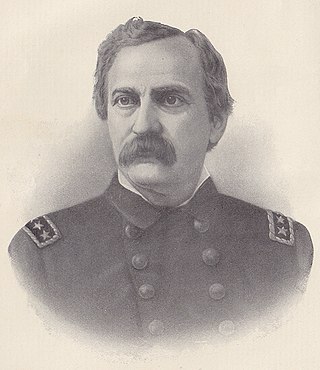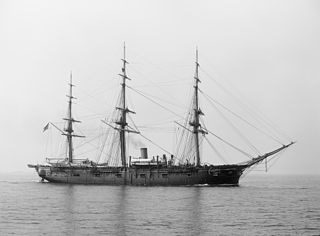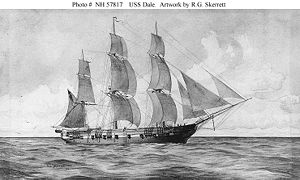
USS Kearsarge, a Mohican-class sloop-of-war, is best known for her defeat of the Confederate commerce raider CSS Alabama off Cherbourg, France during the American Civil War. Kearsarge was the only ship of the United States Navy named for Mount Kearsarge in New Hampshire. Subsequent ships were later named Kearsarge in honor of the ship.

The first USS Essex of the United States Navy was a 36-gun or 32-gun sailing frigate that participated in the Quasi-War with France, the First Barbary War, and in the War of 1812. The British captured her in 1814 and she then served as HMS Essex until sold at public auction on 6 June 1837.

USS Dale was a sloop-of-war in the United States Navy commissioned on 11 December 1839. Dale was involved in the Mexican–American War, the American Civil War, operations along Africa to suppress slave trade, and was used by the U.S. Revenue Cutter Service and later the U.S. Coast Guard, among other activities. Dale was placed into ordinary numerous times.

USS Marion was a sloop-of-war of the third rate in the Union Navy during the American Civil War launched at the Boston Navy Yard on 24 April 1839. On 10 November 1839, she departed Boston on her first cruise, to Brazil. Sunk when heaved down in the harbor at Rio de Janeiro early in 1842, she was raised and sailed back to Boston, arriving in May. She then set sail for the Caribbean, returning in May 1843. For the next few years, she remained in ordinary at Boston and then cruised off the West Coast of Africa and in the Mediterranean until 1848. She captured the Casket, a slaver, near Cabinda on 2 August 1846. After a tour in the East Indies from 1850 to 1852, she resumed operations with the African Squadron from 1853 to 1855 and 1858-60, capturing three more slaving ships: Brothers off Mayumba on 8 September 1858 and Orion and Ardennes in late April 1859 off the coast of Kongo. 1856-57 was spent in ordinary at Norfolk.

USS Yorktown was lead ship of her class of steel-hulled, twin-screw gunboats in the United States Navy in the late 19th and early 20th centuries. She was the second U.S. Navy ship named in honor of the American Revolutionary War's Battle of Yorktown.

William Harwar Parker was an officer in the United States Navy and later in the Confederate States Navy. His autobiography, entitled Recollections of a Naval Officer 1841–1865, provides a unique insight into the United States Navy of the mid-19th century during an era when the Age of Sail was coming to an end and the advent of steam power and ironclads was beginning.

The second USS Portsmouth was a wooden sloop-of-war in the United States Navy in service during the mid-to-late 19th century. She was designed by Josiah Barker on the lines of a French-built privateer, and built at the Portsmouth Navy Yard, directly across the Piscataqua River from Portsmouth, New Hampshire. She was described as an improvement over USS Saratoga built in the same shipyard a year earlier. Portsmouth was launched on 23 October 1843 and commissioned on 10 November 1844, with Commander John Berrien Montgomery in command.

The first USS Lancaster was a screw sloop-of-war in the United States Navy during the American Civil War through the Spanish–American War.
USS Germantown was a United States Navy sloop-of-war in commission for various periods between 1847 and 1860. She saw service in the Mexican–American War in 1847–1848 and during peacetime operated in the Caribbean, in the Atlantic Ocean off Africa and South America, and in East Asia. Scuttled at the outbreak of the American Civil War in 1861, she was captured and refloated by the Confederate States of America and placed in service with the Confederate States Navy as the floating battery CSS Germantown before again being scuttled in 1862.
The first USS Relief was a supply ship in the United States Navy.
The first USS Mohican was a steam sloop-of-war in the United States Navy during the American Civil War. She was named for the Mohican tribe and was the first ship of her class.
USS John Hancock was an armed steam tug in the United States Navy during the 1850s. She was named for Founding Father John Hancock and saw action against rioters in Massachusetts, filbusters in Cuba, rebels in China, and Native Americans in the Washington Territory. She took part in a hydrographic surveying expedition to East Asia and the Pacific Ocean.

The first USS Tuscarora was a Mohican-class sloop of war in the United States Navy during the American Civil War.

USS Saranac was a sloop-of-war of the United States Navy. The ship laid down in 1847 during the Mexican–American War; however, by the time she completed sea trials, the war was over. She was commissioned in 1850 and saw service protecting American interests in the Atlantic Ocean as well as the Pacific Ocean.

The first USS Narragansett was a 2nd class screw sloop in the United States Navy during the American Civil War. Narragansett was built at the Boston Navy Yard, launched on 15 February 1859, and commissioned on 6 November 1859.

The second USS Mohican was a steam sloop of war in the United States Navy. She was named for the Mohican tribe.
USS Fredonia was an 800-ton bark that served the U.S. Navy as a transport and as a storeship. After several voyages to California by way of Cape Horn, she became the station warehouse in Arica, where she was destroyed by an earthquake.

USS Mohongo, an iron‑hulled, schooner‑rigged gunboat, was laid down at New York City by Zeno Secor & Co., Jersey City, N.J., in 1863; launched on 9 July 1864; and commissioned at New York Navy Yard on 23 May 1865, Capt. J. W. A. Nicholson in command.
USS Resaca was a third-class screw steamer of the United States Navy. Built at Portsmouth Navy Yard, Maine at a cost of $201,229.19, the ship was launched on 18 November 1865, and commissioned in 1866, Comdr. J. M. Bradford in command.

Esmeralda was a 44-gun frigate built in Port Mahón, Balearic Islands in 1791 for the Spanish Navy. The First Chilean Navy Squadron, under the command of Thomas Cochrane, captured her on the night of 5 November 1820. She was renamed Valdivia in Chilean service. She was beached at Valparaíso in June 1825.














